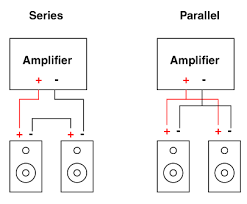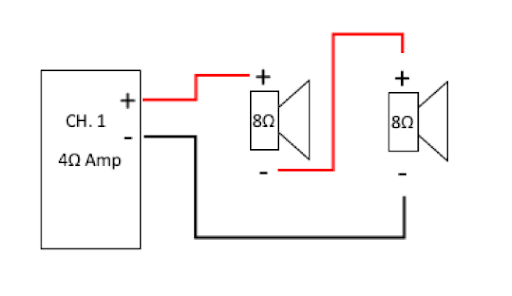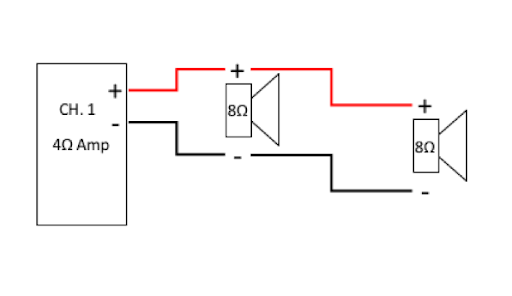You are probably sitting in your living room, worried about how you will install your speakers.
That’s okay because it looks very complicated but, trust me, it’s easy. There are two common ways of installing speakers; series and parallel wiring.
Let’s first learn how to wire a single speaker to understand these two. Installing a single speaker is easy, and anyone can do it. You connect the amplifier to the speaker.
The trouble begins when you add other speakers.
So here, you have to choose between series or parallel wiring. Series wiring means the voltage passes around each speaker.
The negative terminal on the first speaker connects to the second speaker’s positive terminal. The cycle can continue with as many speakers as possible. On the last speaker, the negative terminal connects to the amplifier.
Parallel wiring is different from series. It’s the simplest and the most common. The negative leads are combined, whereas the positive charges are also connected.
The speakers are plugged into the amplifier individually in the corresponding terminals. The voltage goes to speaker one, the amplifier, and so on.
Table Of Contents
- 1 Can I Wire Speakers in Series?
- 2 What Happens When You Wire Speakers in Series?
- 3 What Happens When You Wire Speakers in Parallel?
- 4 When should I connect speakers in the series?
- 5 How Do You Connect Speaker Wires in Parallel?
- 6 Does Wiring Speakers in Parallel Increase Wattage?
- 7 Can You Run 2 speakers Off 1 Channel?
- 8 Can I run 4 speakers Off a 2-Channel Amp?
- 9 Can I wire 4 speakers in parallel?
- 10 Can You Daisy Chain Speakers?
- 11 Series/Parallel Speaker Wiring Calculator
- 12 Wiring Speakers in Parallel Ohms
- 13 Wiring Speakers in Parallel Wattage
- 14 Conclusion
Can I Wire Speakers in Series?
Yes, you can wire your speakers in series. They are easy to learn and design. If your speakers are less than 8 ohms or your amplifier needs a total load impedance of 4 ohms, series wiring suits your needs.
Series wiring has its advantages that go well with you. For instance, If your applications are around flammable sources, then series wiring is ideal for you mainly because they don’t overheat quickly.
Remember, before you wire your speakers in series, it’s also good to know their downfalls. Series wiring has lower power and volume. So if you aim to have a high-volume loudspeaker in your home, then series wiring won’t favor you.
One important thing to note in a series wiring is that if one speaker fails, all the speakers stop working. If you space apart the speakers, too, it can be a hustle to reconnect them.
Related: How to Make a Bluetooth Speaker Louder? (Simple Steps)
What Happens When You Wire Speakers in Series?
When you wire speakers in series, the resistance increases; for example, if you put two 8-ohm speakers in series, the load becomes 16 ohms.
The voltage passes in speakers in series. Meaning it goes to speaker one, then two, and then back to the amplifier.
That’s why resistance increases, and according to ohms law, it decreases the current overall. Therefore, if one speaker fails to work, it affects the rest of the speakers. Resistance affects voltage, and voltage affects volume. We can equate the decrease in voltage to a light bulb.
What happens if you light three bulbs in a series? You will have a wire from the amplifier to the bulb, then from the bulb to the next. Therefore, the bulb will remain dim since they are sharing the voltage. That is what happens to speakers in series wiring.
Thus, the more resistance, the less volume a speaker produces. Here is the summary in a diagram form.
What Happens When You Wire Speakers in Parallel?
When you wire speakers in parallel, the resistance of the speaker decreases, two 8 ohms hooked up in a speaker results in a 4 ohms load.
Each speaker receives full voltage from the amplifier. Therefore, it has less impedance which means its volume is high.
In parallel, the speakers are independent of the amplifier while wired to each other.
Here, if one speaker has a problem, the rest of the speakers will continue to work. That is because they are independent of each other. Below is a summary of the effects of wiring speakers in parallel.
|
Parallel circuit |
The outcome of wiring speakers in parallel |
| Sound | Loud |
| The resistance | Decreases |
| Wattage | Increases |
| Ohms load | Divides according to the number of speakers. |
When should I connect speakers in the series?
You should connect your speakers in series if both speakers are less than 8 ohms or the amplifier needs a total load impedance of 4 ohms.
Choosing the wiring of your speaker depends mainly on the impedance. It’s often written on the back of the speaker or speakers box.
Related: Woofer Vs Subwoofer – A Detailed Comparison
How Do You Connect Speaker Wires in Parallel?
Parallel wiring is the most common wiring used. Each speaker is independent. Here are simple steps to connect your wires in parallel.
- Start by connecting the negative and positive wires from the left side of the amp to one of the left sides of the speakers.
- Connect the first speaker to the next speaker, connecting positive wires to positive and negative to negative.
- Repeat the process for the rest of the speakers. Keep in mind to use the right-side terminals on the amp.
You will end up using more wires resulting in a clumsy look. But when wired correctly, you will enjoy a solid sound from the four speakers.
Does Wiring Speakers in Parallel Increase Wattage?
Yes, wiring speakers in parallel to an amplifier increases wattage. Parallel wiring causes much more power to each resistor.
The wattage increases as the impedance drop to half, resulting in more volume. The diagram below explains it well.
Can You Run 2 speakers Off 1 Channel?
Yes, you can run two speakers off one channel. But you must follow the impedance rule. For example, if both speakers are 8 ohms and above, you use parallel wiring. Series wiring is ideal if the speakers are less than 8 ohms.
Can I run 4 speakers Off a 2-Channel Amp?
Yes, you can run four speakers off a 2-channel amp. However, you must be keen on the impedance of the speakers and divide the power equally to both channels.
The wiring used here will depend on your speakers and amplifiers. Both of them have impendence limits that they should observe.
As said earlier, when you connect in series, it increases the impedance while decreasing in parallel. Therefore, keep an eye on the maximum and minimum impedance a speaker can hold. Overloading will cause more harm than good.
Can I wire 4 speakers in parallel?
Yes, it is possible to wire four speakers in parallel, but it is not a good idea. It puts so much strain on the amplifier, which will later cause more harm. Some people confuse this with daisy chain speakers.
Can You Daisy Chain Speakers?
Yes, it is possible to daisy chain speakers. It’s the best and simplest solution to connect multiple speakers to one audio.
That makes it possible to extend the sound input signal to all speakers connected to the chain.
It is common in conference rooms, meetings, or at-home audio systems with single power output connected to many lounge speakers.
Series/Parallel Speaker Wiring Calculator
Knowing a speaker’s total impedance, power supply, and voltage is very useful. Here we are going to discuss how to calculate them.
You can calculate up to four speakers. The process is friendly; you type the impedance of each speaker into the white space.
Select whether they are parallel or series. The speaker impedance calculator will display the total impedance of the setup and its complete load impedance configuration.
To calculate the speaker’s voltage, you type the speaker’s power in watts and total resistance in ohms. As simple as that, and you get your speakers voltage.
The amplifier voltage calculator is the next step. Enter the input/source voltage and the amplifier gain into the calculator.
Wiring Speakers in Parallel Ohms
Matching your speaker load with your amplifiers gives you room to enjoy. First, you will get the maximum transfer of power. Another reason is that you can sometimes approach the dangers of your amp if you have the incorrect load.
Let’s look at the speaker’s configuration in parallel ohms. The wiring configuration for two speakers. Two 4-ohm speakers = 2-ohm load, Two 8-ohm speakers = 4-ohm load, and Two 16-ohm speakers = 8-ohm load.
At the same time, the wiring configuration for four speakers reads as follows.
Four 8-ohm speakers = 2-ohm load Four 16-ohm speakers = 4-ohm load Four 32-ohm speakers = 8-ohm load
Wiring Speakers in Parallel Wattage
When you wire speakers in parallel, their wattage increases; if two speakers connect in parallel to an amp, the impedance is halved, and the wattage doubles.
Therefore, what was 100 watts at 8 ohms ended at 200 watts at 4 ohms. Someone might ask if the 200 watts is for both speakers or just one speaker. It is 100 amps each, the amp is sourcing 200 amps, but the impedance of each speaker gets each 100 amps of it.
Conclusion
By now, you know which wiring suits you best. If you need loudspeakers, go to parallel wiring. Wiring them in series will result in less volume and a less efficient circuit.
One thing to note in this wiring is that, in sequence, if one speaker fails to work, the rest of the speakers stop working. In contrast, parallel wiring is not affected by the failure of one speaker.




